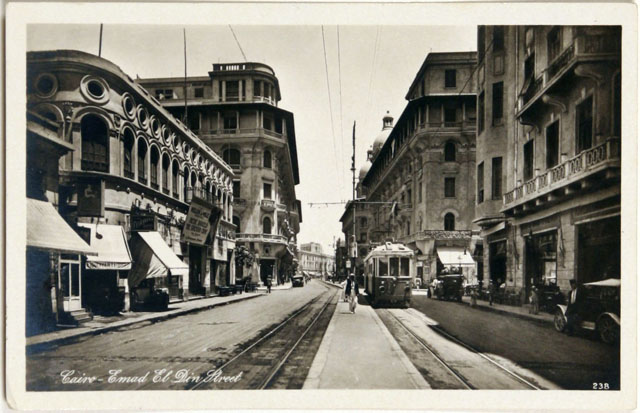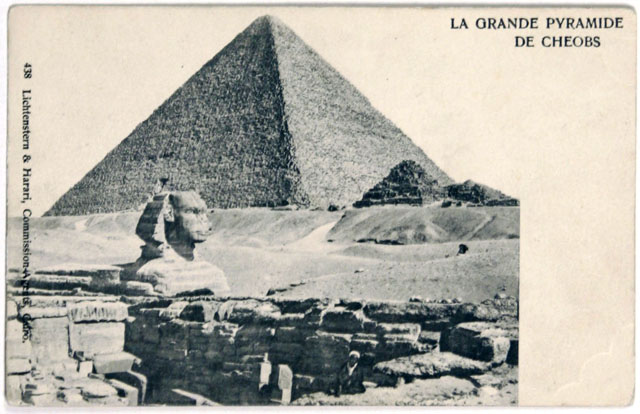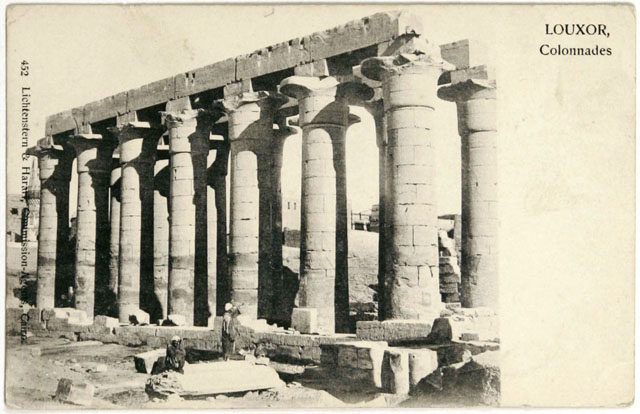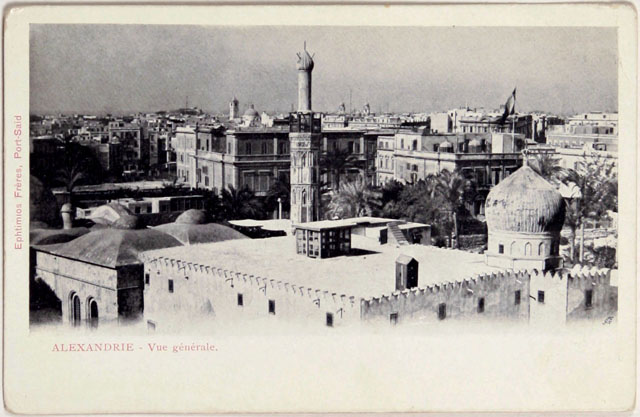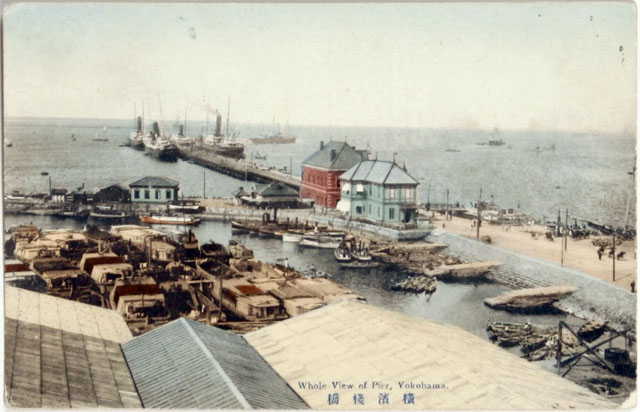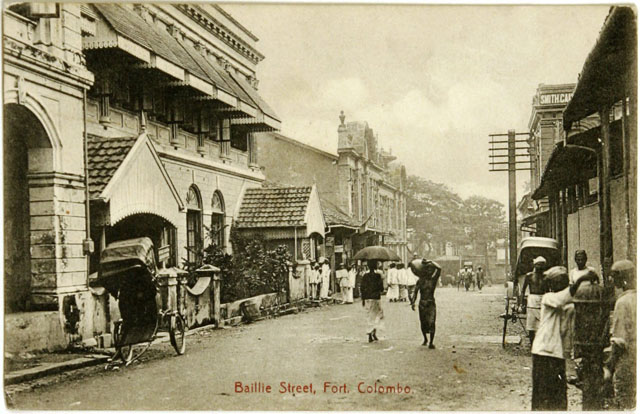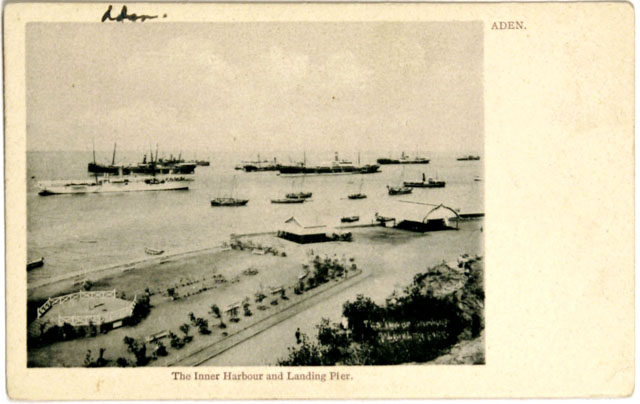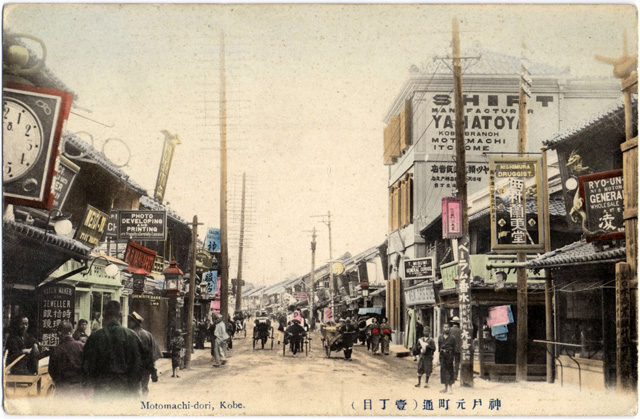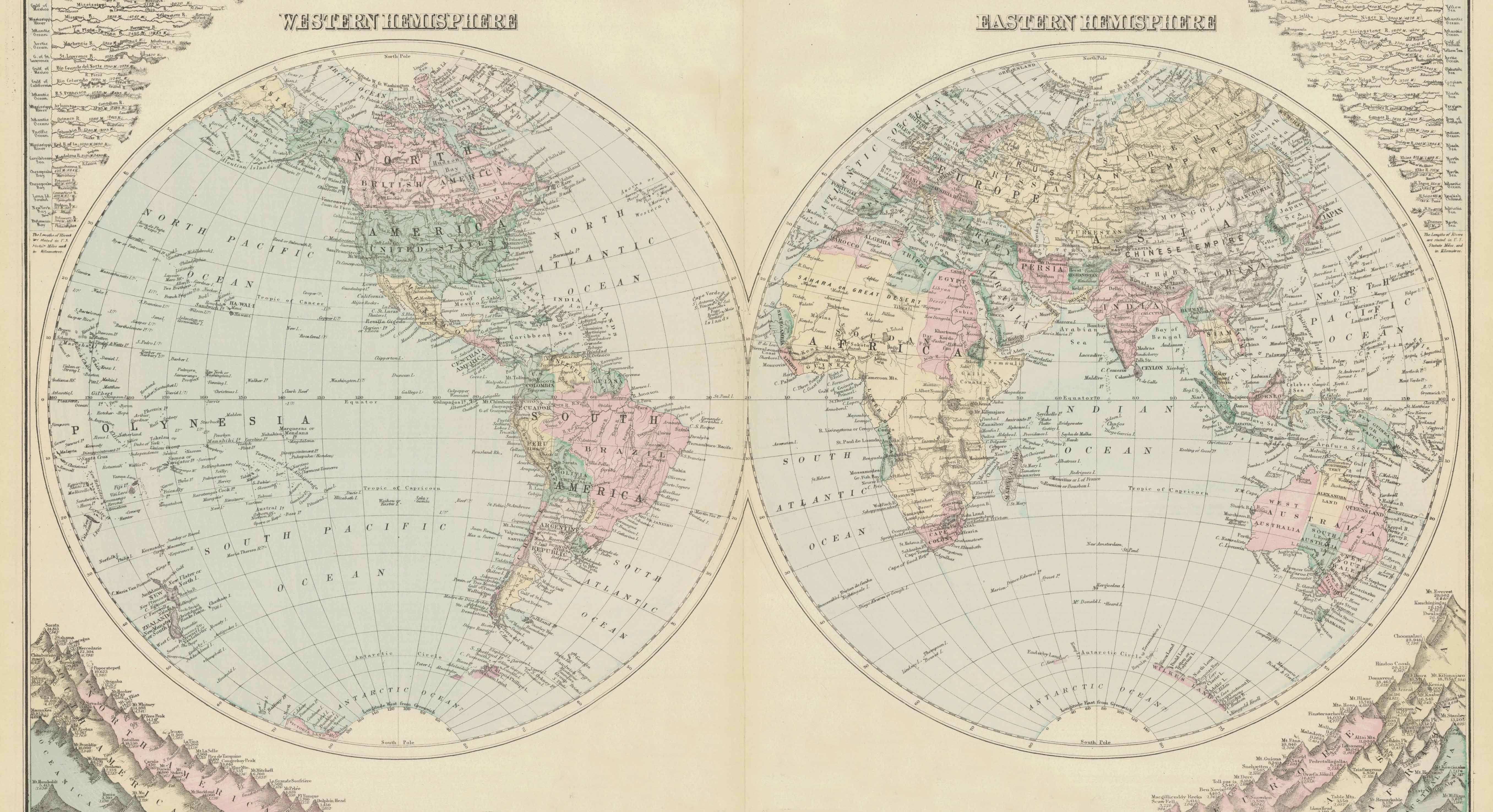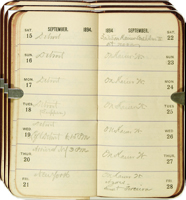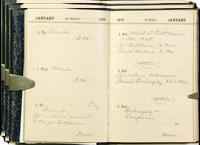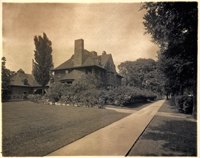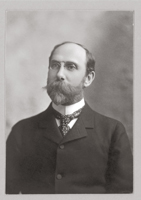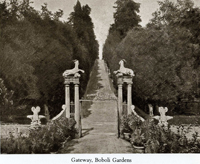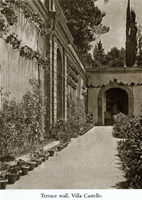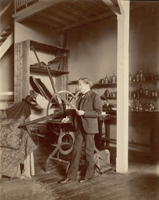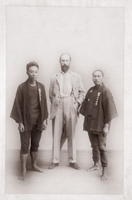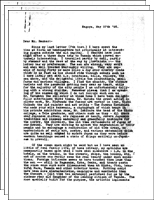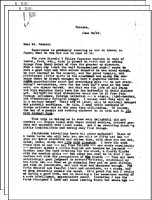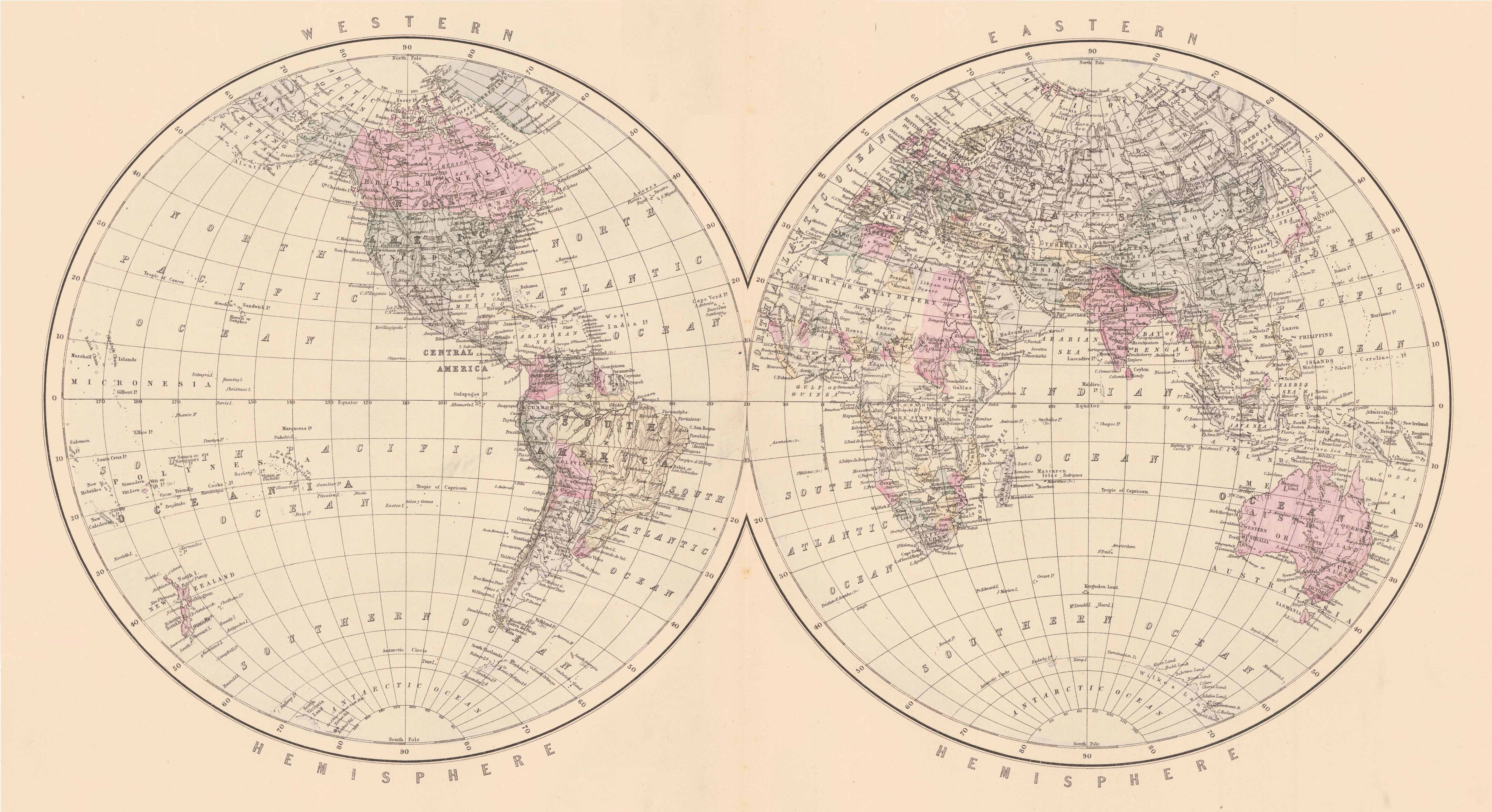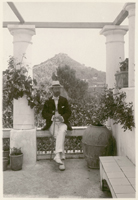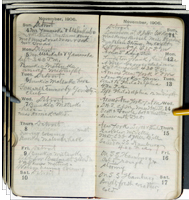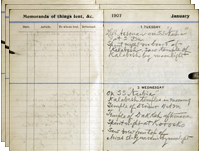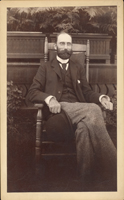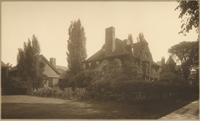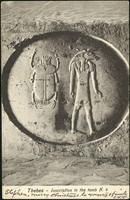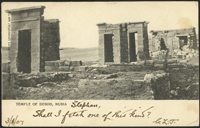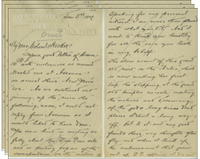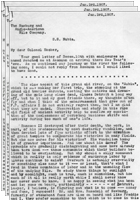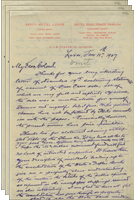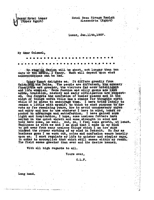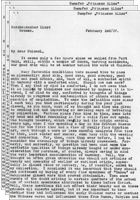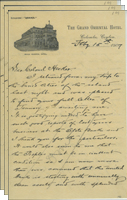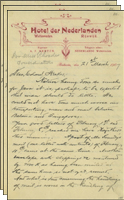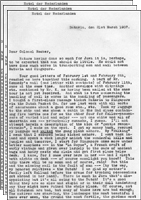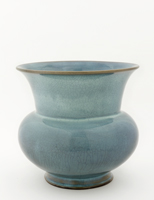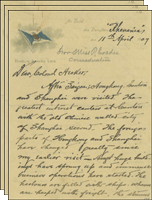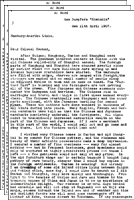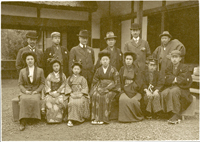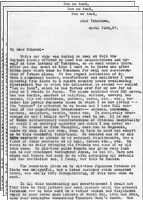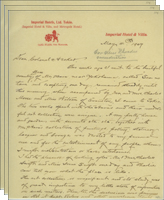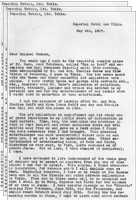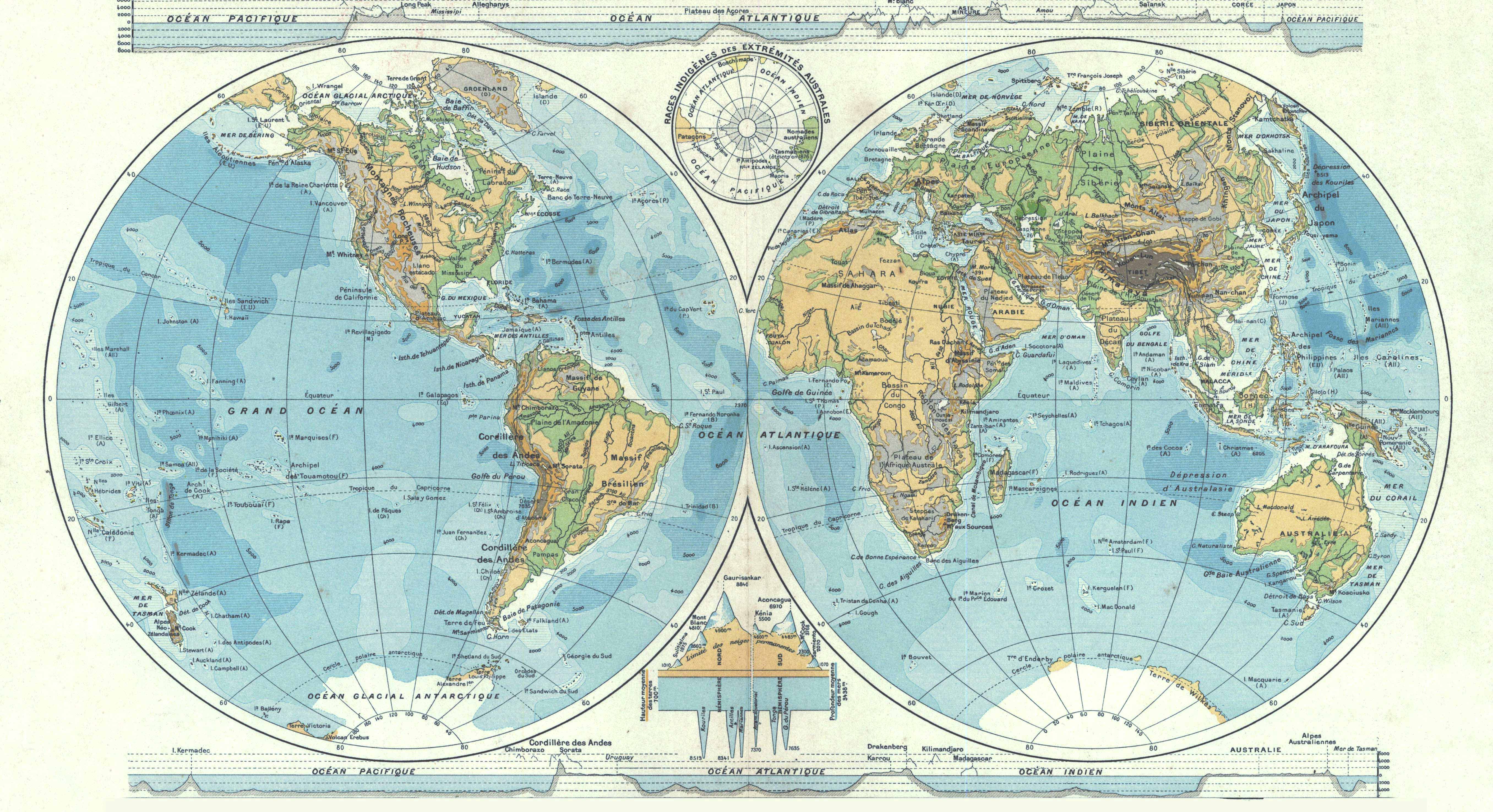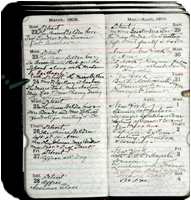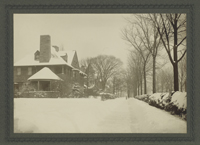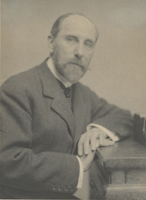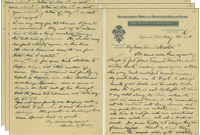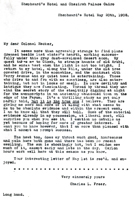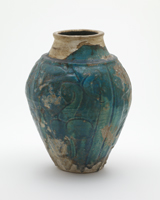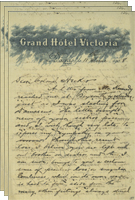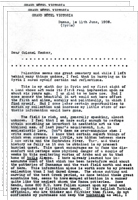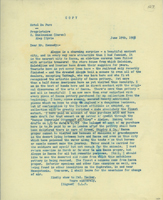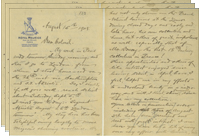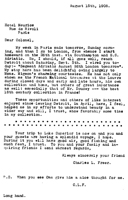Select a tour and travel around the world with Charles Lang Freer. Browse artifacts, correspondence, and photographs, and learn how his tours of Asia affected his aesthetic philosophy and collecting practice.
Period postcards collected by Russell Hamilton, illustrating sites visited by Freer.
Seeking Rest and Pleasure
Charles Lang Freer departed for his first journey to Asia in the fall of 1894, hoping to "free myself from work for a year and seek rest and pleasure in the old world." He crossed the Atlantic, lingering for a month in Italy before going to France, where he embarked from Marseilles, crossed the Mediterranean, and sailed through the Suez Canal to Ceylon (Sri Lanka). From there, he went to India, Singapore, Hong Kong, and Shanghai. He arrived in Japan in the spring of 1895, just in time for the cherry blossoms.
En route to East Asia, Freer spent several weeks in Paris with James McNeill Whistler, where they discussed "points of contact" between the painter’s work and the art of Japan. (Freer had begun to acquire Japanese woodblock prints in 1892, the same year he purchased The Balcony, his first oil painting by Whistler.) Some years later, Freer recollected that Whistler told him he had come to believe ukiyo-e prints, which were widely popular among European and American collectors and consumers, were merely the "last gasp of a great tradition." He urged Freer to travel to Asia and seek out older and rarer examples of painting and pottery to harmonize with his growing collection of works by Whistler.
Freer’s first trip to East Asia did not result in significant purchases of artwork. He traveled as a tourist and returned to Detroit with an idealized memory of Japan that markedly affected his development as a collector. From 1897 to 1902 his collections of East Asian—and especially Japanese—ceramics grew to more than 650 objects. He purchased the ceramics chiefly from the New York branch of Yamanaka and Company and from the Boston-based dealer Matsuki Bunkyo. Other significant purchases came through the Paris-based dealer Siegfried Bing or were acquired at auction from American and British collections.
Itinerary for Freer's First Asian Tour, 1894-1895
- September 1894 [departs Detroit]
- New York City
- Genoa [12 days]
- Tours major cities in Italy [one month, following Platt's itinerary in Italian Gardens]
- Paris [2 weeks]
- Marseilles
- Alexandria
- Suez Canal to Indian Ocean
- Colombo, Ceylon (Sri Lanka) [December 13]
- Anuradhapura, Ceylon [December 25, 1894]
- Overnight steamer across Gulf of Mannar [January 3, 1895]
- India:
- Bombay-Ellora-north to Jodhpur-Delhi-Lahore-Peshawar-Khyber Pass-Agra-Fatehpur Sikri-Benares (Varanasi)-Calcutta-Darjeeling-Calcutta
- Colombo
- Singapore
- Hong Kong
- Shanghai
- Nagasaki
- Kobe
- Kyoto
- Hozu
- Nara
- Uri
- Nagoya
- Nikko
- Kyoto
- Kobe
- Detroit
On September 15, 1894, Freer departed Detroit by train, and stopped briefly in New York City before setting sail on the Kaiser Wilhelm II on September 22. He returned home almost exactly a year later, on September 12, 1895.
After disembarking at Genoa, Freer traveled through Italy, spending considerable time in Tuscany, where he methodically toured the villas and gardens described in a recently published book by the architect Charles Adams Platt. Freer would later commission Platt to design the Freer Gallery of Art in Washington.
-
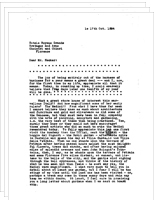
Freer to Frank Hecker, October 17, 1894
[excerpt of letter] "What a great store house of interest this marvelous Italy!!...To fully appreciate this let one first visit the Academy then the Uffizi, next the Pitti – the Loggia dei Signori – the Bobli garden --- afterwards drive to Castello and spend the day at Villa Castello and Villa della Petraia."
Before embarking for Asia from Marseilles, Freer spent two weeks in Paris, where he visited Whistler and other America artists, including the painter Thomas Dewing and the sculptor Frederick MacMonies. Whistler had been occupied with printing a new sequence of lithographs, and Freer was pleased to purchase twenty "specially choice impressions" directly from the artist.
-
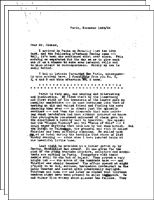
Freer to Frank Hecker, November 16, 1894
[excerpt of letter] "Paris is very gay, and amusing and interesting and instructive. My first visit to the Luxembourg and first sight of the treasures of the Louvre gave me peculiar sensations---in some instances like that of meeting an old and valued friend and finding him more charming than ever --- and in some cases just the opposite emotions..."
Although Freer had not previously expressed an interest in Indian art, his sojourn there in January of 1895 made a profound impression. "It's tremendously interesting," he wrote to his business partner, Frank Hecker, shortly before moving on to Japan, by way of Singapore and Hong Kong. His description of the social and economic situation in Bombay is tellingly paternalistic.
-
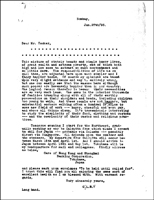
Freer to Frank Hecker, January 27, 1895
[excerpt of letter] "This mixture of stately beauty and simple happy lives, of great wealth and extreme poverty, out of which both high and low seem to extract so much contentment and so little care....The masses here although much poorer are immensely happier than in our country."
Freer's final destination was Japan, where he spent the spring and summer of 1895. His letters, several written in the Japanese fashion, with brush and ink, detail his delight in the beauty of the Japanese countryside and convey, as well, his disappointment at the encroachments of modernity in cities such as Yokohama and Tokyo. Although Freer did not purchase many works of art on this first trip to Japan, he did enjoy meeting a number of Japanese collectors, artists, and scholars.
-

Charles Lang Freer to Frank J. Hecker, Scroll letter, June 26, 1895
[excerpt of scroll] "Jinriksha travelling beats all other methods!! Think of a human horse who will haul you one mile or fifty per day --- whom you never overdrive and seldom tire, with whom you can eat, drink, smoke, and live with pleasure."
Confronting "Tremendous Changes...in the Fierce Race for Wealth and Power"
More than a decade separated Charles Lang Freer’s first trip to Asia (1894 and 1895) from the next four tours (1906 to 1911). In the intervening years, he orchestrated a major corporate merger of thirteen railroad manufacturing companies. Immediately after this, he retired from active business in 1899 to devote himself to collecting full time. In 1900 he purchased a villa in Capri with his friend, Michigan attorney Thomas Spencer Jerome. There, he frequently enjoyed the company of his longtime associate and personal physician from Detroit, Dr. Frederick Wharton Mann, who had purchased the house next to Freer’s Villa Castello. In 1906, Mann accompanied Freer on his trip to Egypt. Freer would continue on to East Asia and returned to Detroit in July 1907.
After the turn of the twentieth century, high-quality Japanese ceramics were increasingly difficult to acquire in the West, and Freer began to collect Near Eastern wares from Syria, Iraq, and Iran that had recently come onto the Western art market. In 1902 he purchased his first pieces of Near Eastern Raqqa ware from the Paris-based dealer Dikran Kelekian, and he quickly amassed a large collection.
Freer’s newfound interest in the arts of the Near East prompted him in 1906 to embark for Egypt, where he purchased ancient Greek biblical manuscripts from a dealer in Cairo. Initially uncertain about their authenticity, Freer nevertheless confessed that they "carried me completely off my feet." The works, subsequently referred to as the Washington Manuscripts, are one of the greatest treasures Freer acquired. In Detroit he kept the biblical manuscripts in a fireproof safe behind the leaded-glass door of the Peacock Room. In 1908 George Swain photographed the manuscripts and the Peacock Room at Freer’s request.
Freer left Egypt for Ceylon and India early in 1907; he arrived in Hong Kong on Easter Sunday. In China he acquired numerous ceramics, including Han dynasty tomb jars and a large array of blue-glazed Jun wares, that became part of the decoration of the Peacock Room in Detroit.
Freer’s second tour to Asia ended in Japan, where the idyllic memories of his first trip in 1895 were temporarily disrupted by the harsh realities of life in the modern cities of Yokohama and Tokyo. "The changes going on in Japan are terrible—everything is being Europeanized!" he wrote to his business partner Frank Hecker.
No longer an anonymous tourist, Freer was known by Japanese dealers and collectors as an important connoisseur. He was invited to the country estate of Hara Tomitaro, a prominent Japanese businessman and collector. During his two-week visit, Freer relished Hara’s elegant gardens and the traditional architecture of his home. The experience mitigated Freer’s disillusionment and allowed him to revive his earlier notion of Japan as a pleasant idyll.
Through Hara, Freer gained access to private collections of early Chinese paintings as well as Japanese screens, scrolls, and ceramics. When Freer returned to Detroit via San Francisco in the summer of 1907, his understanding of and access to East Asian art had grown significantly.
Itinerary for Freer's Second Asian Tour, 1906–1907
- November 1906 [departs Detroit]
- New York City [via SS Hamburg]
- Naples [December 5, 1906, on SS Oceana]
- Alexandria [December 8]
- Cairo [two weeks]
- Luxor
- Abu Simel
- Halfa
- Aswan
- Nubia
- Aswan [January 1, 1907]
- Wadi Halfa
- Port Said [January 20]
- Suez Canal-Gulf of Aden
- Colombo, Ceylon
- Singapore
- Batavia [now Jakarta, Indonesia]
- Central Java [Prambanan (Borobudur temple complexes)]
- Singapore
- Saigon
- Hong Kong [Easter Sunday, 1907]
- Canton
- Shanghai
- Kobe
- Yokohama [Hara's villa Sannotani overlooking Yokohama Bay]
- Tokyo
- Yokohama
- San Francisco [July 14, 1907]
- Detroit
"I am now planning to leave Detroit....and go via Naples direct to Cairo, spend a few weeks in Egypt, then go to Ceylon for a short stay, thence to Java, returning to America either next Spring or Summer"
Freer left Detroit for his second trip to Asia on November 11, 1906. He stopped briefly in Kingston, New York, to visit family and then embarked from New York on the SS Hamburg, continuing his journey aboard the SS Oceana, which sailed from Naples to Alexandria, Egypt on December 5. More than ten years had passed since his first Asian tour, but his collections had expanded considerably. After overseeing the merger of thirteen railroad car-buliding companies, Freer retired from business to pursue a life of "active idleness," as he described it. In 1900, he bought a villa in Capri with his friend, the archaeologist Thomas S. Jerome. There, he frequently enjoyed the company of his longtime associate and personal physician from Detroit, Dr. Frederick Wharton Mann, who had purchased the house next to Freer's Villa Castello. In 1906, he accompanied Freer on his trip to Egypt.
Freer spent two weeks in the middle of December 1906 in Cairo, staying at Shepheard’s Hotel, a luxurious establishment catering to wealthy American and British tourists. Freer and his traveling companion, the Detroit physician Frederick Wharton Mann, took in all of the major ancient and medieval monuments and archaeological sites, guided by Breasted’s History of Egypt, well as Gaston Migeon’s recently-published Caire, le Nil et Memphis, a gift from the author. (Migeon was part of the circle of Paris-based collectors and dealers including Dikran Kelekian and Siegfried Bing who had introduced Freer to the arts of the Near East.) After Cairo, Freer and Mann journeyed up the Nile, exploring the temples of Luxor, Abu Simbel, and Wadi al-Sebua. Freer enjoyed the contrast between these sites and the modern, cosmopolitan atmosphere in Cairo. "Upper Egypt delights me," he wrote to Frank Hecker. "Here fashion and silly gowns are laid aside, tradition, history and early civilization are respected. One forgets the confusion of busier places and. . . happiness is with me."
-
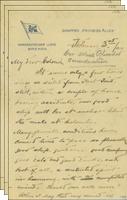
Freer to Frank Hecker,February 3, 1907
[excerpt] "I felt most keenly a desire to step as rapidly as possible from Egyptian art, in its home, to Japanese art, in its home. This will enable me to compare under best conditions possible the best art of the two countries, and learn more accurately their difference, their qualities, their harmonies and discords."
Freer sailed from Port Said on January 21, 1907 on the North German Lloyd liner the Princess Alice through the Suez Canal and the Gulf of Aden en route to Ceylon. Writing from Ceylon to his business partner, Frank Hecker, he described his "trip up country" to see Buddhist cave temples and "buried cities" at Matale, Dambulla, Anuradhapura, Mihintale, Polonnaruwa, and Sigiriya. He contrasted this "a rare experience" to the city of Colombo, which had undergone significant modernization since Freer's previous visit some twelve years before.
Freer arrived in Batavia (now Jakarta, Indonesia), the capital of the Dutch East Indies in early March 1907. He was excited to see Buddhist and Hindu temples at Prambanan and Borobudur, which he had read about in the Reverend George M. Reith's 1897 book A Padre in Partibus: Being Notes and Impressions of a Brief Holiday Tour through Java, the Eastern Archipelago and Siam. After a day spent studying ninth-century Buddhist sculpture at the great Borobudur temple complex, he watched the sunset from atop the stupa. It was, Freer wrote in his diary, the "most beautiful view of my life."
After arriving in Hong Kong on Easter Sunday of 1907, Freer purchased a number of ceramics from local dealers. His shopping for pottery continued while on a short visit to Canto. It was during this trip to China that Freer acquired many examples of blue-glaze Jun ware that he would later arrange on the south wall of the Peacock Room, just below Whistler's allegorical mural of two fighting peacocks.
On Freer's second trip to Japan, he was a well-known collector, and he travelled with letters of introduction from the noted scholar Ernest Fenollosa, giving him access to important private collections, including those belonging to Hara Tomitarō, a prominent banker and silk merchant with whom Freer formed an enduring friendship, and Masuda Takashi, whom Freer described as "the richest collector of Japan." During his two months in Japan, Freer made trips to Kobe, Yokohama, Kyoto, and Tokyo. He returned to Detroit, by way of San Francisco, on July 19, 1907.
-
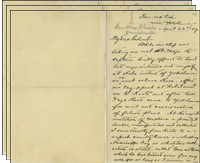
Freer to Frank Hecker, April 23, 1907
[excerpt] "At the urgent invitation of Mr. Hara, a prominent banker, manufacturer and collector, I came directly from Kioto to a superb country house overlooking Mississippi Bay in which his collection is stored --- called "San no tani," which he has turned over for my use for as long as I remain in Japan."
An Eager Student on a Quest to the Holy Land"
Freer’s stated aim on his 1908 trip to "the Holy Land" was to gain a greater understanding of works in his Near Eastern ceramics collection: "My quest to the ‘Holy Land’—Racca pottery," he wrote to Frank Hecker, his former business partner. "I have invested pretty heavily in this line of ‘fayence’ and I consider it necessary to learn what I can." With this in mind, he visited Cairo, Aleppo, Beirut, Jerusalem, and Istanbul, and he purchased forty-six ceramic objects from local dealers.
In 1902 Freer acquired his first pieces of Raqqa ware, a type of ceramic named for the site in north-central Syria where it had been excavated. (Some of the wares that Freer identified as Raqqa are now understood to have been produced at other sites.) These turquoise- and green-glazed vessels with gritty white bodies and thick alkaline glazes appealed to Freer because of their chromatic correspondences with his extensive holdings of East Asian ceramics and American tonalist paintings.
Over the next fifteen years Freer amassed a significant collection of Syrian and Persian Iranian ceramics, with many purchases made from the Paris-based dealers Dikran Kelekian and Siegfried Bing. Kelekian had started selling antique Islamic ceramics in the 1880s and 1890s and was one of the earliest purveyors of Raqqa. In 1909 Kelekian published The Potteries of Persia, in which he described the wares as "beautiful in color and heavily encrusted with iridescence." He noted that "discriminating collectors . . . have grown to love it with a deep and abiding affection quite within the scope of their own emotional experiences."
Freer also purchased a number of Near Eastern ceramics from Siegfried Bing, who supplied him with Japanese wares in the late 1890s. Bing played a key role in introducing Japanese art to audiences in Europe and beyond. As the market in Japanese art began to decline after the turn of the twentieth century, Bing sold textiles and ceramics from the Islamic world after excavations in the 1890s made new goods available to European art and antiques dealers.
Little scholarship on Raqqa and other types of Near Eastern pottery existed during Freer’s time. Based on the highly abraded, iridescent surfaces of the pottery, many dealers and collectors thought the wares were much older than they are now known to be. Freer was aware of the limits of available knowledge. He wrote to Hecker from Syria, "I have already learned how inaccurate much of that which has been hitherto said about the potteries of Damascus and the vast field north and east. This information alone is worth more to my personal collection than I had dared dream." Accurate information on dating and kiln sites for Raqqa and other medieval Near Eastern ceramics was not widely available until after World War II.
Itinerary for Freer's Third Asian Tour, 1908
- Detroit
- New York City
- Naples
- Capri
- Naples
- Port Said [May 14, 1908–Mediterranean terminus of Suez Canal]
- Cairo
- Alexandria
- Jerusalem
- Beirut
- Damascus
- Baalbek
- Aleppo
- Rhodes
- Smyrna [then through the Dardanelles to...]
- Constantinople
- Athens
- Corinth
- Patras
- Olympia
- Corfu
- Trieste
- Vienna
- Budapest [boards the Orient Express to...]
- Paris
- New York City [August 26]
- Detroit
After spending much of the winter at home in Detroit, Freer departed in the spring for a trip to West Asia. "My quest to the ‘Holy Land'— Racca Pottery," he explained to Frank Hecker. He embarked from Boston, where he took the opportunity to meet with the dealer Matsuki Bunkyo and Okakura Kakuzō, a scholar of Japanese art who was a key advisor to the collector Isabella Stewart Gardner and the author of The Book of Tea.
In Cairo, Freer met with Ali Arabi, the dealer from whom he had purchased the ancient biblical manuscripts the year before. Learning more about the origins of these manuscripts was a major motivation for the trip to Egypt. He also confessed to Frank Hecker that he had come to enjoy bargaining with local dealers, and he made a number of acquisitions, including bronze figures, carved limestone reliefs, and amulets made of faience, metal, stone, and glass.
Freer spent the first few days of June in Jerusalem, visiting the major religious sites in the old city. From there he travelled to Beirut and then to Syria, where he visited Damascus, Baalbek, and Aleppo, which he found to be "a charming surprise---a beautiful ancient city." Part of its appeal was its proximity to Raqqa, the city where so many of Freer's ceramics were believed to have been produced. In Aleppo, which he described as "the store house" from which his Western-based dealers had "drawn their supplies," Freer purchased several pieces of pottery from street vendors.
Freer concluded his trip to West Asia by way of Europe. He departed from Constantinople on July 5, 1908, and stopped at a number of cities in Greece. By August 1 he was in Vienna, boarding the Orient Express to Paris. On September 6, he returned home to Ferry Avenue in Detroit. Between 1909 and 1911, Freer would make two more tours of Asia. By 1912, his health was seriously failing, and his days as a globetrotting connoisseur came to an end. The last years of his life, spent largely in New York City, were spent culling and organizing his collections and planning their display at the museum in Washington. Freer died in 1919. The Freer Gallery of Art, the first art museum of the Smithsonian Institution, opened to the public some three years later, in 1923.

